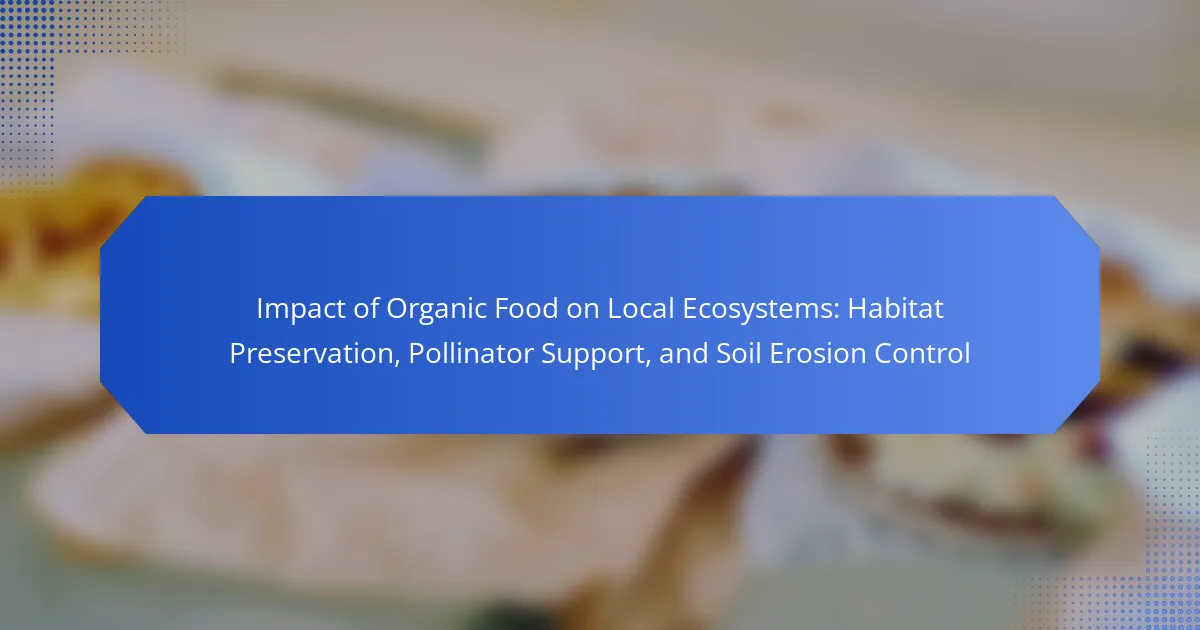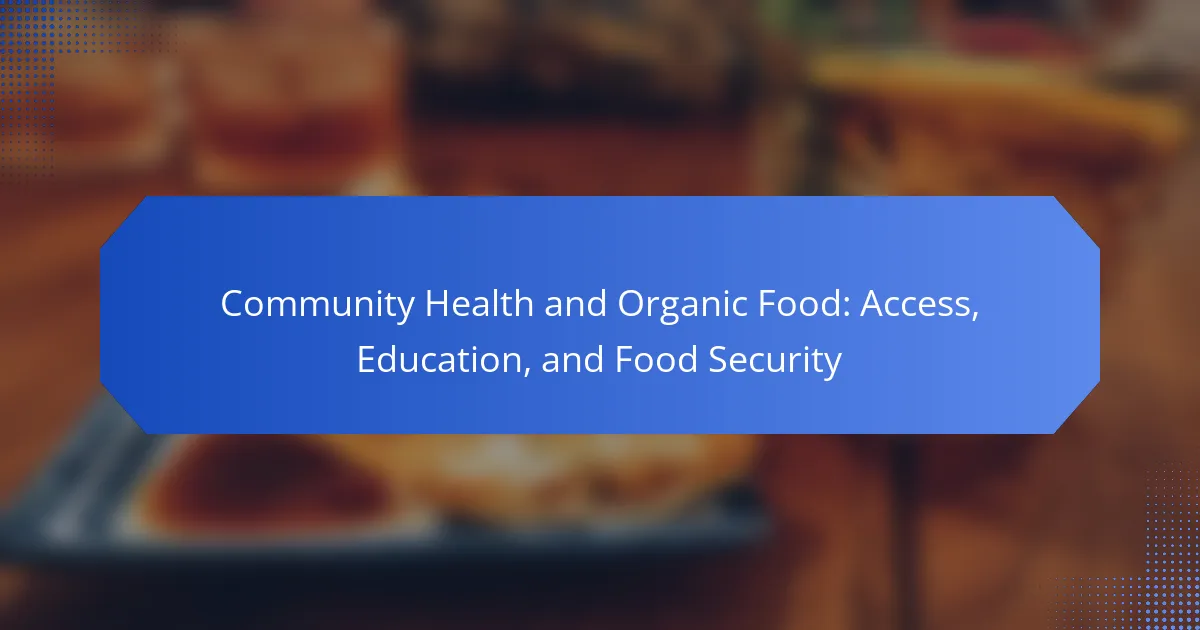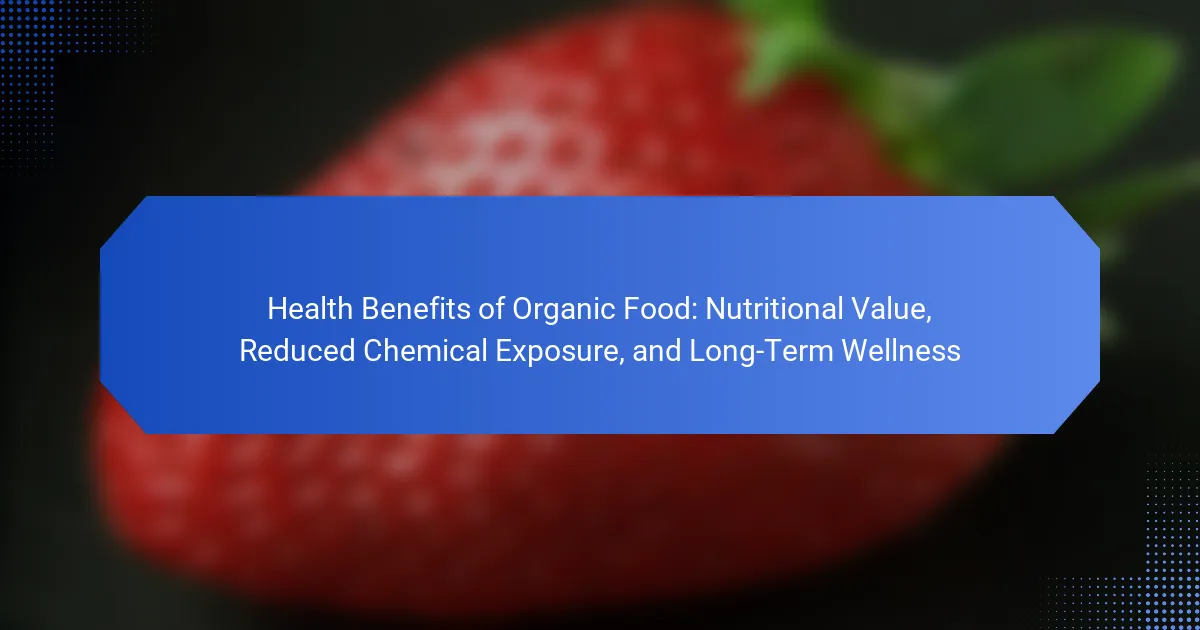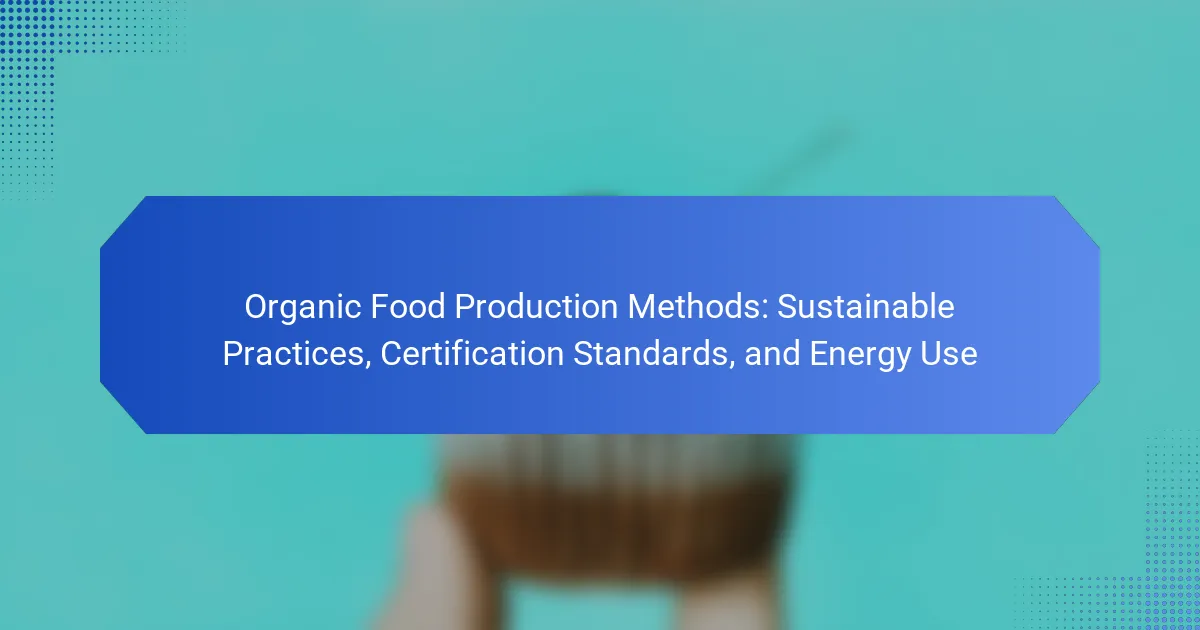The Organic Food Supply Chain encompasses the entire network involved in the production, processing, distribution, and sale of organic food products, including key stakeholders such as farmers, processors, distributors, retailers, and consumers. This article examines the impact of transportation emissions within this supply chain, highlighting strategies for optimizing logistics and reducing carbon footprints through local sourcing, fuel-efficient vehicles, and technology for real-time tracking. Additionally, it addresses sustainable packaging solutions, including biodegradable, compostable, and reusable materials, which contribute to waste reduction and environmental sustainability. The growing consumer demand for organic products and the significant increase in organic farmland underscore the importance of a well-functioning and eco-friendly supply chain.
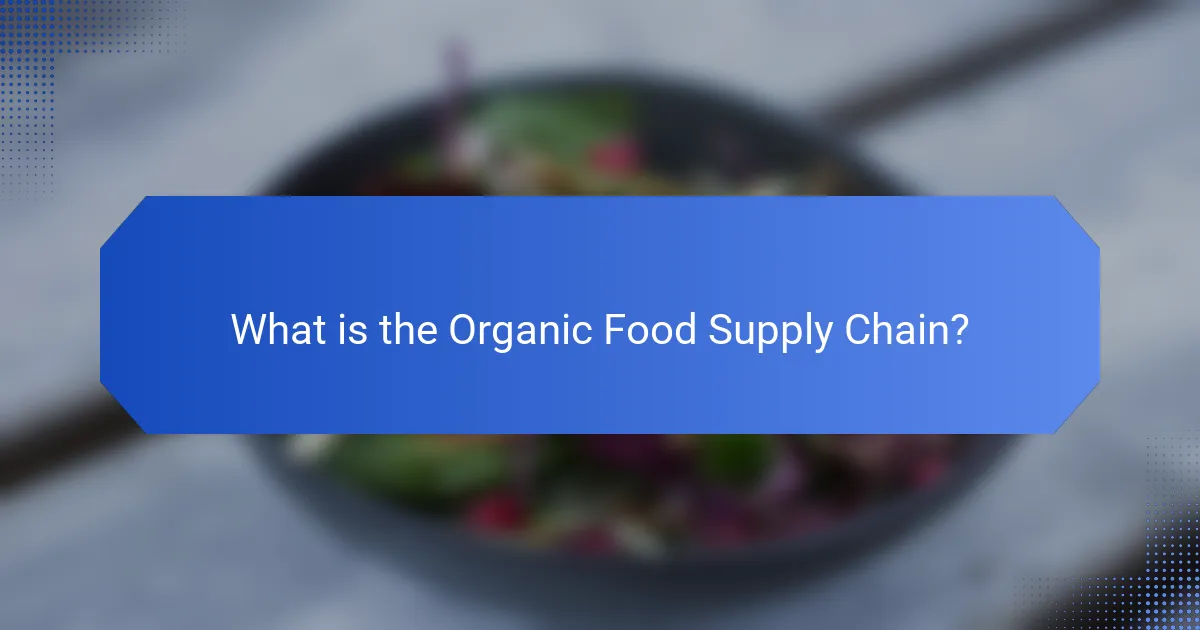
What is the Organic Food Supply Chain?
The Organic Food Supply Chain refers to the network involved in producing, processing, distributing, and selling organic food products. This chain includes various stakeholders such as farmers, processors, distributors, retailers, and consumers. Each participant plays a crucial role in maintaining the integrity and quality of organic food. Organic farming practices emphasize sustainable methods and avoid synthetic fertilizers and pesticides. The supply chain must adhere to strict regulatory standards to ensure products are certified organic. According to the USDA, organic farming has seen a significant increase, with over 3 million acres of farmland dedicated to organic production in the U.S. as of 2021. This growth reflects a rising consumer demand for organic products, highlighting the importance of a well-functioning supply chain.
How does the Organic Food Supply Chain function?
The Organic Food Supply Chain functions through a series of interconnected processes. It begins with organic farming, where crops are grown without synthetic pesticides or fertilizers. Farmers then harvest these crops and prepare them for distribution. The harvested produce is transported to processing facilities, where it may be packaged or further prepared for sale.
Transportation plays a critical role, as it involves moving organic products from farms to retailers. This process often aims to minimize emissions through efficient logistics. Retailers then sell these organic products to consumers, often emphasizing sustainability in packaging.
Finally, consumers purchase and consume the products, contributing to a cycle that encourages organic farming practices. This supply chain is designed to maintain the integrity of organic standards throughout each step. The demand for organic products has been increasing, with the organic food market valued at $55.1 billion in the U.S. as of 2020, highlighting the effectiveness of this supply chain.
What are the key stages in the Organic Food Supply Chain?
The key stages in the Organic Food Supply Chain are production, processing, distribution, retail, and consumption. Production involves growing organic crops or raising organic livestock under strict regulations. Processing includes transforming raw organic products into packaged goods while maintaining organic standards. Distribution entails transporting the organic products to various markets, ensuring they remain fresh and uncontaminated. Retail is where consumers purchase organic products, often through specialized stores or online platforms. Consumption is the final stage, where consumers prepare and eat organic foods. Each stage is essential for maintaining the integrity and quality of organic food.
How do these stages impact overall sustainability?
The stages of the organic food supply chain significantly impact overall sustainability. Transportation emissions contribute to greenhouse gas output, affecting climate change. Sustainable packaging reduces waste and resource consumption. Waste reduction initiatives minimize landfill contributions and promote recycling. Each stage’s efficiency influences resource use and environmental footprint. For instance, optimizing transportation routes can lower emissions by up to 20%. Sustainable practices in packaging can decrease plastic pollution significantly. Overall, integrating sustainability at each stage enhances the organic food supply chain’s ecological viability.
What are the environmental implications of the Organic Food Supply Chain?
The environmental implications of the Organic Food Supply Chain are significant. Organic farming practices generally result in lower greenhouse gas emissions compared to conventional methods. This is due to the avoidance of synthetic fertilizers and pesticides, which contribute to pollution. Additionally, organic farms often utilize crop rotation and cover cropping, enhancing soil health and biodiversity.
Transportation within the organic supply chain can also impact the environment. Organic products often travel longer distances to reach consumers, increasing carbon emissions. However, local organic sourcing can mitigate this effect.
Packaging sustainability is another critical aspect. Many organic brands prioritize eco-friendly materials, reducing plastic waste. This shift contributes positively to reducing landfill contributions and ocean pollution.
Lastly, waste reduction strategies are commonly implemented in organic supply chains. These include composting and recycling initiatives that minimize waste generation. Overall, while the organic food supply chain has environmental benefits, it also presents challenges that must be addressed for optimal sustainability.
How does transportation contribute to emissions in the Organic Food Supply Chain?
Transportation significantly contributes to emissions in the Organic Food Supply Chain. The movement of organic products from farms to consumers often requires long-distance transport. This distance increases fuel consumption and greenhouse gas emissions. According to the USDA, transportation can account for up to 11% of total emissions in the food supply chain. Additionally, the type of vehicles used impacts emission levels. Heavy-duty trucks typically emit more pollutants compared to lighter, more efficient vehicles. Furthermore, inefficient routing and delays can exacerbate emissions. Overall, transportation plays a crucial role in the environmental footprint of organic food products.
What role does packaging play in sustainability?
Packaging plays a crucial role in sustainability by influencing resource use and waste generation. Sustainable packaging reduces environmental impact through materials that are recyclable, biodegradable, or made from renewable resources. For instance, biodegradable packaging can decompose naturally, minimizing landfill waste. Additionally, using lightweight materials can decrease transportation emissions, as lighter packages require less fuel. According to a 2020 study by Smithers Pira, sustainable packaging can reduce carbon footprints by up to 50%. Furthermore, effective packaging design can enhance product protection, leading to less spoilage and waste in the organic food supply chain.
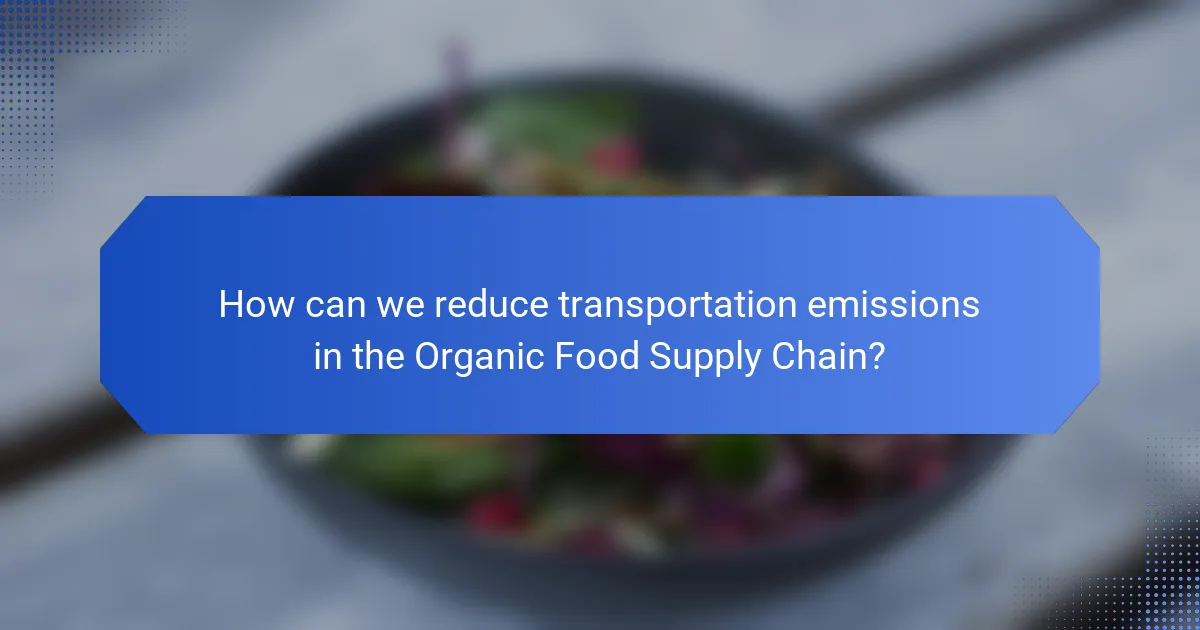
How can we reduce transportation emissions in the Organic Food Supply Chain?
To reduce transportation emissions in the Organic Food Supply Chain, companies can optimize logistics and implement efficient routing. Utilizing local sourcing minimizes transportation distances. Employing fuel-efficient vehicles reduces overall emissions significantly. Transitioning to electric or hybrid vehicles further lowers carbon footprints. Implementing consolidated shipments decreases the number of trips required. Utilizing technology for real-time tracking enhances route efficiency. According to a study by the USDA, optimizing transport can reduce emissions by up to 30%. These strategies collectively contribute to a more sustainable organic food supply chain.
What strategies are effective for minimizing transportation emissions?
Implementing fuel-efficient vehicles is an effective strategy for minimizing transportation emissions. These vehicles utilize advanced technology to reduce fuel consumption. Transitioning to electric or hybrid vehicles further decreases greenhouse gas emissions. Optimizing delivery routes can also minimize travel distances and time. This approach reduces fuel usage and emissions significantly.
Encouraging the use of public transportation lowers the number of individual vehicles on the road. Carpooling and ridesharing initiatives can also reduce overall transportation emissions. Investing in infrastructure for cycling and walking promotes sustainable travel options.
Finally, adopting alternative fuels, such as biofuels or hydrogen, can further reduce emissions. These strategies collectively contribute to a more sustainable transportation system in the organic food supply chain.
How does route optimization affect emissions?
Route optimization reduces emissions by improving transportation efficiency. It minimizes the distance traveled and reduces fuel consumption. For instance, optimized routes can decrease travel time by up to 20%. This leads to lower greenhouse gas emissions per trip. According to a study by the Environmental Protection Agency, efficient routing can cut emissions by 10-30%. By reducing idle time and ensuring smoother traffic flow, route optimization directly contributes to decreased air pollution. Overall, effective route planning is crucial for sustainable transportation in the organic food supply chain.
What alternative transportation methods can be utilized?
Alternative transportation methods include bicycles, electric vehicles, and public transit. Bicycles provide a zero-emission option for short distances. Electric vehicles reduce greenhouse gas emissions compared to traditional gasoline cars. Public transit systems, such as buses and trains, can transport multiple passengers efficiently. These methods contribute to lower transportation emissions. Studies show that shifting to these alternatives can significantly reduce the carbon footprint of food supply chains. For instance, using electric vehicles can cut emissions by up to 50% compared to conventional vehicles.
What are the benefits of reducing transportation emissions?
Reducing transportation emissions leads to improved air quality and public health. It decreases pollutants like nitrogen oxides and particulate matter. Cleaner air results in fewer respiratory illnesses and related healthcare costs. Lower emissions also contribute to climate change mitigation. This helps in stabilizing weather patterns and reducing extreme weather events. Additionally, it promotes sustainability within the organic food supply chain. Sustainable practices enhance brand reputation and consumer trust. Studies show that reducing emissions can lead to significant cost savings in fuel and maintenance.
How does emission reduction impact consumer perception?
Emission reduction positively impacts consumer perception by enhancing brand image and trust. Consumers increasingly prioritize sustainability in their purchasing decisions. A study by Nielsen found that 73% of millennials are willing to pay more for sustainable products. Brands that demonstrate commitment to emission reduction often attract environmentally conscious consumers. This shift in perception can lead to increased customer loyalty and sales. Companies that effectively communicate their emission reduction efforts can differentiate themselves in a competitive market. Ultimately, emission reduction aligns with consumer values, fostering a positive relationship between brands and their customers.
What financial savings can be achieved through emission reduction?
Emission reduction can lead to significant financial savings for businesses. Companies can save on energy costs by implementing more efficient technologies. For example, switching to renewable energy sources can reduce electricity bills. Transportation efficiency improvements can lower fuel expenses. According to the International Energy Agency, improving energy efficiency in transport can save up to 30% in fuel costs. Additionally, reduced emissions may lead to lower regulatory compliance costs. Companies can also benefit from tax incentives for sustainable practices. Overall, emission reduction strategies can enhance profitability while promoting environmental sustainability.
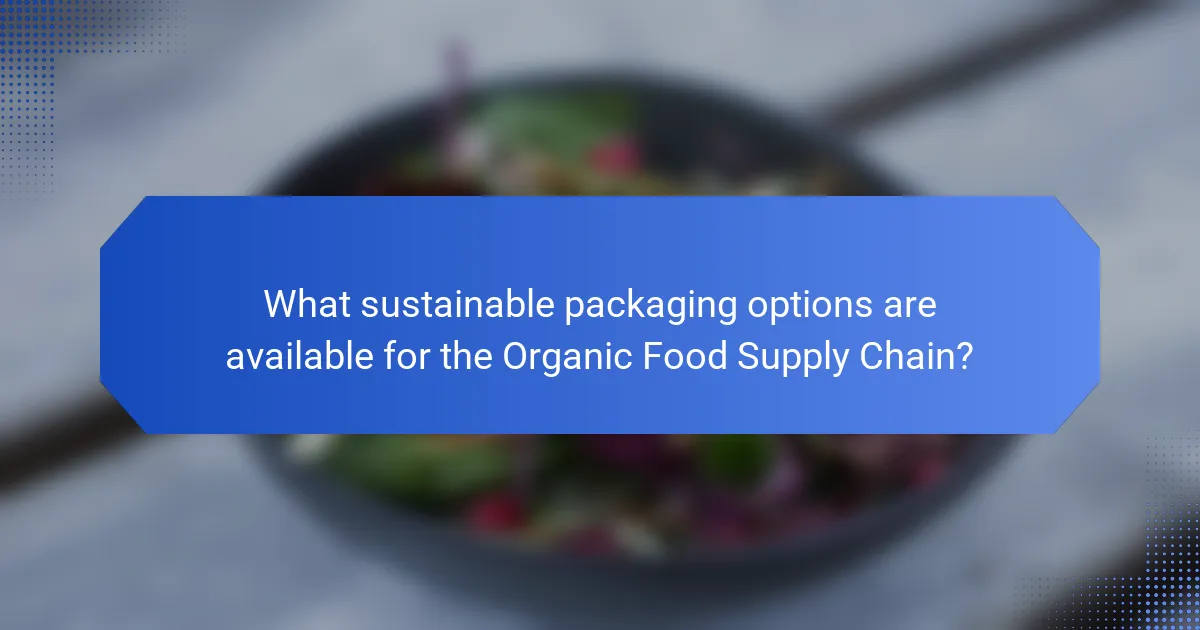
What sustainable packaging options are available for the Organic Food Supply Chain?
Sustainable packaging options for the Organic Food Supply Chain include biodegradable materials, compostable packaging, and reusable containers. Biodegradable materials break down naturally, reducing landfill waste. Compostable packaging can decompose into nutrient-rich soil, benefiting the environment. Reusable containers minimize single-use waste and promote sustainability. Additionally, recycled materials can be utilized to create packaging, reducing the need for virgin resources. These options contribute to a more eco-friendly supply chain by lowering carbon footprints and waste generation.
What materials are considered sustainable for packaging?
Sustainable packaging materials include biodegradable plastics, recycled paper, and glass. Biodegradable plastics break down naturally, reducing landfill waste. Recycled paper is made from post-consumer waste, conserving resources. Glass is reusable and recyclable, minimizing environmental impact. Other sustainable options are plant-based materials and metal. Plant-based materials are derived from renewable resources. Metal packaging is highly recyclable and has a long lifespan. These materials contribute to reducing carbon footprints in the organic food supply chain.
How do biodegradable materials compare to traditional packaging?
Biodegradable materials are more environmentally friendly than traditional packaging. They decompose naturally, reducing landfill waste. Traditional packaging often consists of plastics that can take hundreds of years to break down. According to the Environmental Protection Agency, plastic waste contributes significantly to ocean pollution. Biodegradable options can reduce greenhouse gas emissions during decomposition. A study by the Journal of Cleaner Production found that biodegradable materials can lower carbon footprints by up to 50%. Additionally, biodegradable packaging often uses renewable resources, unlike traditional packaging made from fossil fuels. This shift promotes sustainability in the organic food supply chain.
What innovations are emerging in sustainable packaging?
Innovations in sustainable packaging include biodegradable materials, reusable packaging systems, and plant-based alternatives. Biodegradable materials break down naturally, reducing landfill waste. Reusable packaging systems encourage multiple uses, minimizing single-use waste. Plant-based alternatives, such as those derived from corn or sugarcane, replace traditional plastics. Companies are also exploring compostable packaging that enriches soil after disposal. Smart packaging technologies track freshness and reduce spoilage. These innovations align with global sustainability goals and consumer demand for eco-friendly solutions.
How does packaging sustainability affect waste reduction?
Packaging sustainability directly reduces waste by minimizing material usage and promoting recyclability. Sustainable packaging often employs biodegradable or recyclable materials. This reduces the volume of waste sent to landfills. According to the Environmental Protection Agency, packaging waste accounts for about 30% of total municipal solid waste. By using sustainable packaging, companies can decrease this percentage significantly. Studies show that companies adopting sustainable practices can reduce their waste output by up to 50%. This shift not only conserves resources but also lowers carbon emissions associated with packaging production and disposal.
What practices can be implemented to minimize packaging waste?
Implementing practices such as using biodegradable materials, reducing packaging size, and adopting reusable packaging can minimize packaging waste. Biodegradable materials break down naturally and reduce landfill impact. Reducing packaging size conserves resources and decreases waste generation. Adopting reusable packaging encourages consumers to return containers, thus minimizing single-use items. Additionally, optimizing supply chain logistics can decrease excess packaging. According to the Environmental Protection Agency, reducing packaging waste contributes significantly to lowering overall waste generation. These practices collectively support sustainability in the organic food supply chain.
How can consumers contribute to reducing packaging waste?
Consumers can contribute to reducing packaging waste by choosing products with minimal or no packaging. They can select bulk items to reduce the total amount of packaging used. Using reusable bags and containers for shopping also helps minimize waste. Additionally, consumers can support brands that prioritize sustainable packaging practices. Recycling packaging materials correctly is crucial for waste reduction. Participating in local recycling programs can further enhance these efforts. According to the Environmental Protection Agency, recycling and composting prevented the release of 186 million metric tons of carbon dioxide equivalent into the air in 2018. This shows the significant impact of consumer actions on reducing packaging waste.
What are best practices for waste reduction in the Organic Food Supply Chain?
Implementing best practices for waste reduction in the organic food supply chain involves several key strategies. First, optimizing inventory management can significantly reduce spoilage. Accurate demand forecasting helps align production with consumer needs. Second, enhancing packaging sustainability minimizes waste. Utilizing biodegradable or recyclable materials is essential. Third, establishing partnerships with local suppliers reduces transportation emissions and waste. This shortens delivery routes and improves freshness. Fourth, educating consumers about proper storage extends product lifespan. This can decrease food waste at the household level. Lastly, adopting composting practices for unsold or damaged goods diverts waste from landfills. These practices collectively contribute to a more efficient and sustainable organic food supply chain.
How can businesses implement waste reduction strategies effectively?
Businesses can implement waste reduction strategies effectively by conducting a waste audit. This audit identifies the types and amounts of waste generated. Next, businesses can set specific waste reduction goals based on audit findings. Training employees on waste management practices is essential for successful implementation.
Additionally, businesses should explore options for recycling and composting materials. Partnering with suppliers who prioritize sustainable practices can also minimize waste. Utilizing technology to track and manage waste can enhance efficiency.
Research shows that companies implementing waste reduction strategies can reduce waste by up to 30%. This statistic highlights the potential for significant impact when strategies are applied correctly.
What are the roles of consumers in waste reduction efforts?
Consumers play a crucial role in waste reduction efforts. They can influence the supply chain through their purchasing decisions. By choosing products with minimal packaging, consumers reduce waste generation. Supporting brands focused on sustainability encourages more companies to adopt eco-friendly practices. Participating in recycling programs helps divert waste from landfills. Additionally, consumers can educate themselves on composting to manage organic waste effectively. Research indicates that consumer awareness significantly impacts waste reduction initiatives. For instance, a study by the Ellen MacArthur Foundation shows that informed consumers can reduce food waste by up to 30%.
How can stakeholders collaborate to enhance sustainability in the Organic Food Supply Chain?
Stakeholders can collaborate to enhance sustainability in the Organic Food Supply Chain by sharing resources and best practices. This collaboration can include joint initiatives for reducing transportation emissions. For example, local producers and distributors can coordinate logistics to minimize travel distances.
Additionally, stakeholders can work together to develop sustainable packaging solutions. Companies can share insights on biodegradable materials and recycling processes. This approach helps reduce waste across the supply chain.
Furthermore, education and training programs can be implemented to promote sustainable practices among all stakeholders. Research shows that collaborative efforts can lead to a 30% reduction in carbon footprint in supply chains.
By aligning goals and strategies, stakeholders can create a more sustainable organic food supply chain.
The Organic Food Supply Chain encompasses the processes involved in producing, processing, distributing, and selling organic food products, highlighting the roles of various stakeholders such as farmers, processors, distributors, retailers, and consumers. This article examines critical aspects of the supply chain, including transportation emissions, packaging sustainability, and waste reduction strategies. It outlines how each stage of the supply chain impacts sustainability and the environment while emphasizing the importance of adhering to organic standards. Additionally, it discusses innovative practices and collaboration among stakeholders to enhance the overall sustainability of the organic food supply chain.
